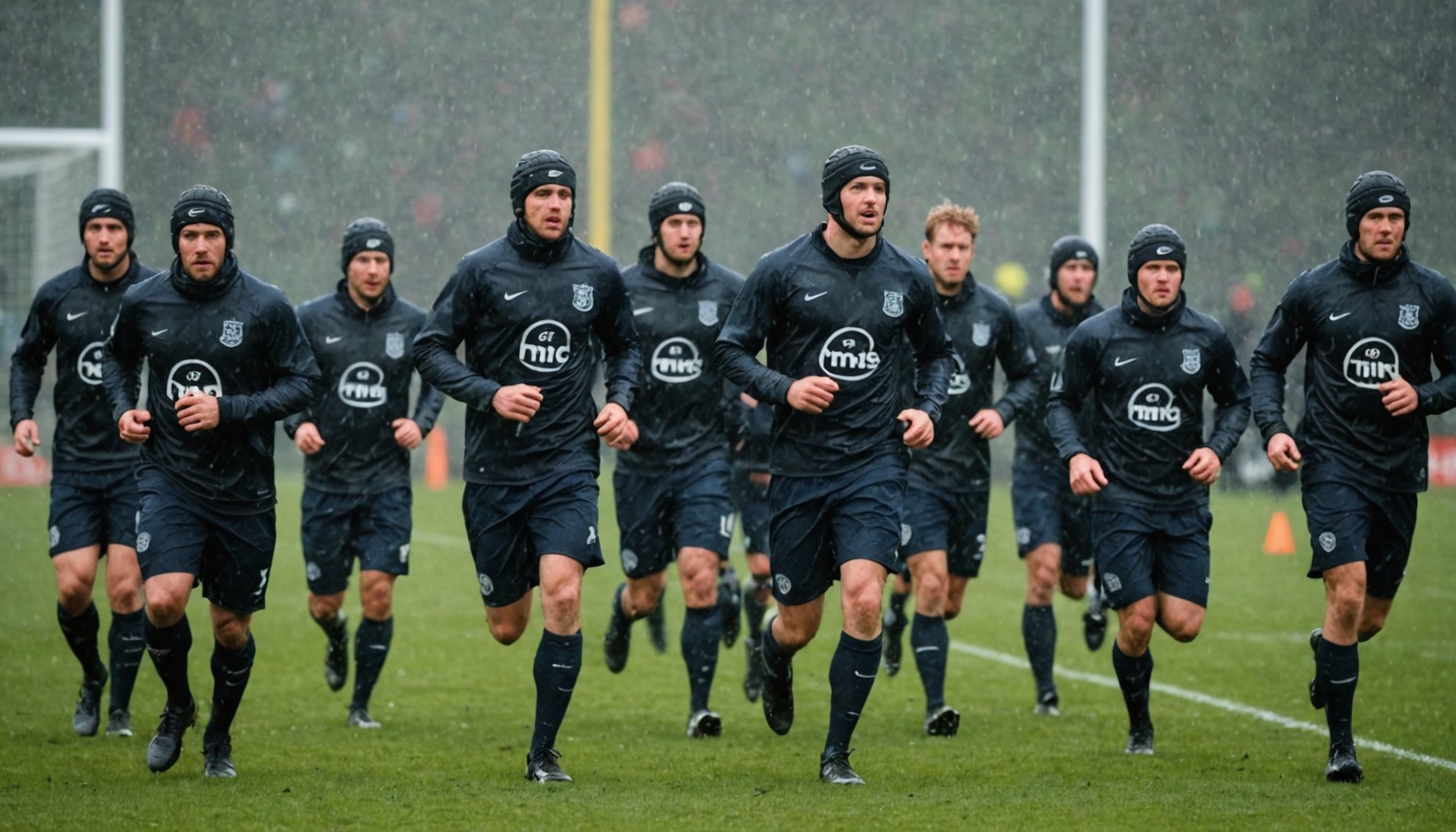Winning Strategies: Top Tactical Changes for Football Teams in Challenging Wet Weather
Playing football in wet weather conditions can be a daunting task for any team. The slick pitch, the fast-moving ball, and the increased risk of injuries all combine to create a challenging environment that demands strategic adaptations. Here’s a comprehensive guide on the top tactical changes football teams can implement to thrive in such conditions.
Adapting Play Style for Wet Weather
When the weather turns wet, the dynamics of the game change significantly. Here are some key adjustments teams need to make to their play style:
In the same genre : Effective Strategies to Minimize ACL Injury Risks in Football: Proven Techniques Revealed
Focus on Ground Passes
In wet conditions, long balls and high crosses become more challenging to execute and control. The solution is to focus more on ground passes. This approach ensures that the ball is kept under control, reducing the risk of it skidding out of control or slipping away from players.
Modify Tackling Techniques
Sliding tackles, which are common in dry conditions, become more dangerous in wet weather due to the slippery surface. Players should opt for standing tackles and interceptions instead, which are safer and more effective in these conditions.
Additional reading : Top Cooling Down Techniques for Football Players: Maximize Recovery Post-Training!
Adjust Shooting Techniques
The wet ball tends to bounce less and move faster, making low, hard shots more effective. These shots can catch goalkeepers off guard, increasing the chances of scoring. Players need to adapt their shooting techniques to take advantage of these conditions.
Optimizing Team Formation and Player Roles
The formation and player roles can significantly impact a team’s performance in wet weather. Here’s how teams can optimize these aspects:
Compact Formation
A more compact formation allows for quicker response times and better cooperation between players. Since players are closer together, they can react faster to the quick, unpredictable movement of the ball. This formation helps in maintaining possession and creating scoring opportunities more effectively.
Reassessing Player Roles
- Defenders: Should focus on clearing the ball from the defensive zone quickly, as any attempt to maintain possession can lead to dangerous turnovers.
- Midfielders: Should concentrate on maintaining possession using short, precise ground passes to navigate through the opposition and set up scoring opportunities.
- Strikers: Should look for opportunities to take shots on goal, exploiting the difficulties goalkeepers face in handling the wet ball.
Using the Weather Condition as a Tactical Advantage
While wet weather poses challenges, it can also be leveraged as a tactical advantage. Here’s how:
Counter-Attacking Strategy
Teams can employ a counter-attacking strategy, using the fast-moving ball to quickly transition from defense to attack. This tactic relies on the opposition losing possession in the slippery conditions, allowing the counter-attacking team to quickly advance the ball towards the opponent’s goal. This strategy requires excellent teamwork and coordination, as well as players who can maintain their balance and control the ball effectively.
Training and Preparation
Preparation is key to performing well in any weather condition. Here are some tips on how teams can prepare:
Pre-Season Training
The strength and conditioning staff and the sports science team play a crucial role in the early season. They need to balance pre-season training to ensure players are match-fit without overtraining, which can lead to fatigue later in the season. A well-planned pre-season can significantly impact the team’s performance in the first 25% of the season.
Adapting Training Regimens
Teams should adapt their training regimens to simulate wet weather conditions. This can include training on wet pitches, practicing ground passes, and honing tackling and shooting techniques suitable for slippery surfaces. Access to scholarly research can provide valuable insights into how different environmental conditions affect the game, helping teams develop effective strategies.
Analyzing Opposition and Match Context
Understanding the opposition and the match context is crucial in making tactical decisions.
Team Styles and Tactics
Some teams are defensively solid but struggle to score, while others prioritize ball possession without converting it into goals. Games between two cautious or evenly matched teams often result in low-scoring encounters and increased chances of a draw. Teams like Atlético Madrid and Juventus have built reputations for keeping tight games, often resulting in draws, especially against equally tactically-minded opponents.
Form and Fatigue
Team form and physical condition play a major role in the likelihood of a draw or a win. Teams on a poor run of form may be more conservative, aiming to avoid another loss. Conversely, top teams that are exhausted from a packed fixture schedule may not play with their usual intensity, leading to a more balanced game than mere form might suggest.
Practical Insights and Actionable Advice
Here are some practical tips and actionable advice for football teams playing in wet weather:
Key Tactical Adjustments
- Use short passes: Focus on short, precise ground passes to maintain possession.
- Avoid long balls: Long balls and high crosses are risky in wet conditions.
- Modify tackling: Opt for standing tackles and interceptions instead of sliding tackles.
- Adjust shooting: Use low, hard shots to exploit the wet ball’s behavior.
- Compact formation: Use a more compact formation to enhance teamwork and reaction times.
Pre-Match Preparation
- Check weather forecasts: Understand the weather conditions before the game to plan accordingly.
- Train on wet pitches: Simulate wet weather conditions in training to prepare players.
- Analyze opposition: Study the opposition’s tactics and form to anticipate their strategy in wet weather.
In-Game Adjustments
- Monitor player fatigue: Be aware of player fatigue and make substitutions accordingly.
- Adjust player roles: Reassess player roles during the game to optimize performance.
- Use counter-attacking: Employ a counter-attacking strategy to capitalize on the opposition’s mistakes.
Table: Tactical Adjustments for Wet Weather
| Tactical Aspect | Adjustment | Reason |
|---|---|---|
| Passing Style | Focus on ground passes | Reduces risk of ball skidding out of control |
| Tackling Techniques | Use standing tackles and interceptions | Safer and more effective in slippery conditions |
| Shooting Techniques | Use low, hard shots | Exploits the wet ball’s behavior to catch goalkeepers off guard |
| Team Formation | Compact formation | Enhances teamwork and reaction times |
| Player Roles | Defenders: Clear ball quickly; Midfielders: Maintain possession; Strikers: Look for shooting opportunities | Optimizes performance in wet conditions |
| Counter-Attacking | Quickly transition from defense to attack | Capitalizes on opposition mistakes in slippery conditions |
Quotes from Football Experts
- “In wet conditions, the ball travels faster, the risk of injury increases, and players’ physical technical abilities can be affected due to lower core temperature. By understanding these factors, teams can make informed decisions on how to adapt their tactics and what preventive measures to take.”
- “The key to understanding why football teams win or lose is to first understand who is responsible for the preparation and performance of the team at key points in the season. This includes the strength and conditioning staff, the coaching staff, and the players.”
- “Weather and pitch conditions can influence the likelihood of a draw, especially in leagues where extreme weather is common. Heavy rain or strong winds can make it difficult for teams to play their usual fluid style, often resulting in fewer goals and a higher probability of a stalemate.”: Harnessing Professional Insights for Wet Weather Play
Wet weather conditions pose unique challenges to football teams, but with the right tactical adjustments, these challenges can be turned into opportunities. By focusing on ground passes, modifying tackling and shooting techniques, optimizing team formation and player roles, and leveraging the weather as a tactical advantage, teams can maintain their performance and even gain an edge over their opposition.
Understanding the opposition’s tactics, team form, and physical condition, as well as preparing adequately through pre-season training and in-game adjustments, are crucial for success. By integrating these strategies and insights, football teams can ensure they are well-prepared to face the challenges of playing in wet weather and come out on top.
In the words of a seasoned football manager, “The key to winning in any condition is not just about the players, but about how well the team adapts and executes its tactics. Wet weather is no exception; it’s about being smart, being prepared, and using the conditions to your advantage.”











